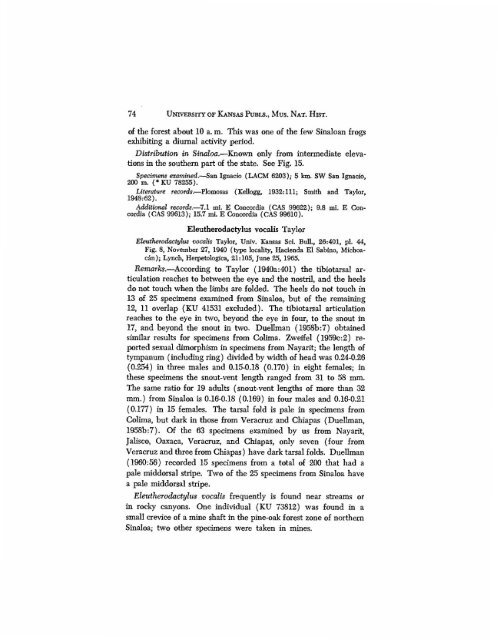The Amphibians and Reptiles of Sinaloa, Mexico - Smithsonian ...
The Amphibians and Reptiles of Sinaloa, Mexico - Smithsonian ...
The Amphibians and Reptiles of Sinaloa, Mexico - Smithsonian ...
Create successful ePaper yourself
Turn your PDF publications into a flip-book with our unique Google optimized e-Paper software.
74 UNIVERSITY OF KANSAS PUBLS., MUS. NAT. HIST.<br />
<strong>of</strong> the forest about 10 a. m. This was one <strong>of</strong> the few <strong>Sinaloa</strong>n frogs<br />
exhibiting a diurnal activity period.<br />
Distribution in <strong>Sinaloa</strong>.—Known only from intermediate elevations<br />
in the southern part <strong>of</strong> the state. See Fig. 15.<br />
Specimens examined.—San Ignacio (LACM 6203); 5 km. SW San Ignacio,<br />
200 m. (*KU 78255).<br />
Literature records.—Plomosas (Kellogg, 1932:111; Smith <strong>and</strong> Taylor,<br />
1948; 62).<br />
Additional records,—7.1 mi. E Concordia (CAS 99622); 9.8 mi, E Concordia<br />
(CAS 99613); 15.7 mi. E Concordia (CAS 99610).<br />
Eleutherodactylus vocalis Taylor<br />
Eleutherodactylus vocalis Taylor, Univ. Kansas Sci. Bull., 26:401, pi. 44,<br />
Fig. 8, November 27, 1940 (type locality, Hacienda El Sabino, Michoacan);<br />
Lynch, Heipetologica, 21:105, June 25, 1965.<br />
Remarks.—According to Taylor (1940a: 401) the tibiotarsal articulation<br />
reaches to between the eye <strong>and</strong> the nostril, <strong>and</strong> the heels<br />
do not touch when the limbs are folded. <strong>The</strong> heels do not touch in<br />
13 <strong>of</strong> 25 specimens examined from <strong>Sinaloa</strong>, but <strong>of</strong> the remaining<br />
12, 11 overlap (KU 41531 excluded). <strong>The</strong> tibiotarsal articulation<br />
reaches to the eye in two, beyond the eye in four, to the snout in<br />
17, <strong>and</strong> beyond the snout in two. Duellman (1958b:7) obtained<br />
similar results for specimens from Colima. Zweifel (1959c:2) reported<br />
sexual dimorphism in specimens from Nayarit; the length <strong>of</strong><br />
tympanum (including ring) divided by width <strong>of</strong> head was 0.24-0.26<br />
(0,254) in three males <strong>and</strong> 0.15-0.18 (0.170) in eight females; in<br />
these specimens the snout-vent length ranged from 31 to 58 mm.<br />
<strong>The</strong> same ratio for 19 adults (snout-vent lengths <strong>of</strong> more than 32<br />
mm,) from <strong>Sinaloa</strong> is 0.16-0.18 (0.169) in four males <strong>and</strong> 0.16-0.21<br />
(0.177) in 15 females. <strong>The</strong> tarsal fold is pale in specimens from<br />
Colima, but dark in those from Veracruz <strong>and</strong> Chiapas (Duellman,<br />
1958b:7). Of the 63 specimens examined by us from Nayarit,<br />
Jalisco, Oaxaca, Veracruz, <strong>and</strong> Chiapas, only seven (four from<br />
Veracruz <strong>and</strong> three from Chiapas) have dark tarsal folds. Duellman<br />
(1960:56) recorded 15 specimens from a total <strong>of</strong> 200 that had a<br />
pale middorsal stripe. Two <strong>of</strong> the 25 specimens from <strong>Sinaloa</strong> have<br />
a pale middorsal stripe.<br />
Eleutherodactylus vocalis frequently is found near streams or<br />
in rocky canyons. One individual (KU 73812) was found in a<br />
small crevice <strong>of</strong> a mine shaft in the pine-oak forest zone <strong>of</strong> northern<br />
<strong>Sinaloa</strong>; two other specimens were taken in mines.
















